在线电子词典应用实训项目
1 项目概述

本实训案例旨在构建一款,可运行于鸿蒙手机、平板电脑、智慧屏乃至智能手表设备上的,电子词典应用。借助该应用,用户可以输入任何英语单词,并查询到相应的词性及中文解释。通过本实训案例,学生可以快速掌握基于Java UI框架的鸿蒙应用开发,并对鸿蒙平台上的数据库操作、网络访问、多设备适配,以及离线与在线方式的数据挖掘技术有一个初步的体验和认知。
2 需求分析
2.1 词典功能
输入英语单词,输出中文解释。
2.2 本地查词
利用爬虫技术构建轻量级本地词库,并作为资源的一部分与应用一起部署到设备端。应用优先在本地词库中查询单词,提高查询速度。
2.3 远程查词
对于本地词库没有的单词,同样利用爬虫技术在远程词库中查询,在向用户显示查询结果的同时,将其存入本地词库,动态扩展词库。
3 核心技术
3.1 多设备适配技术
同一套程序支持在多种设备上运行:
- 手机
- 平板电脑
- 智慧屏
- 智能手表
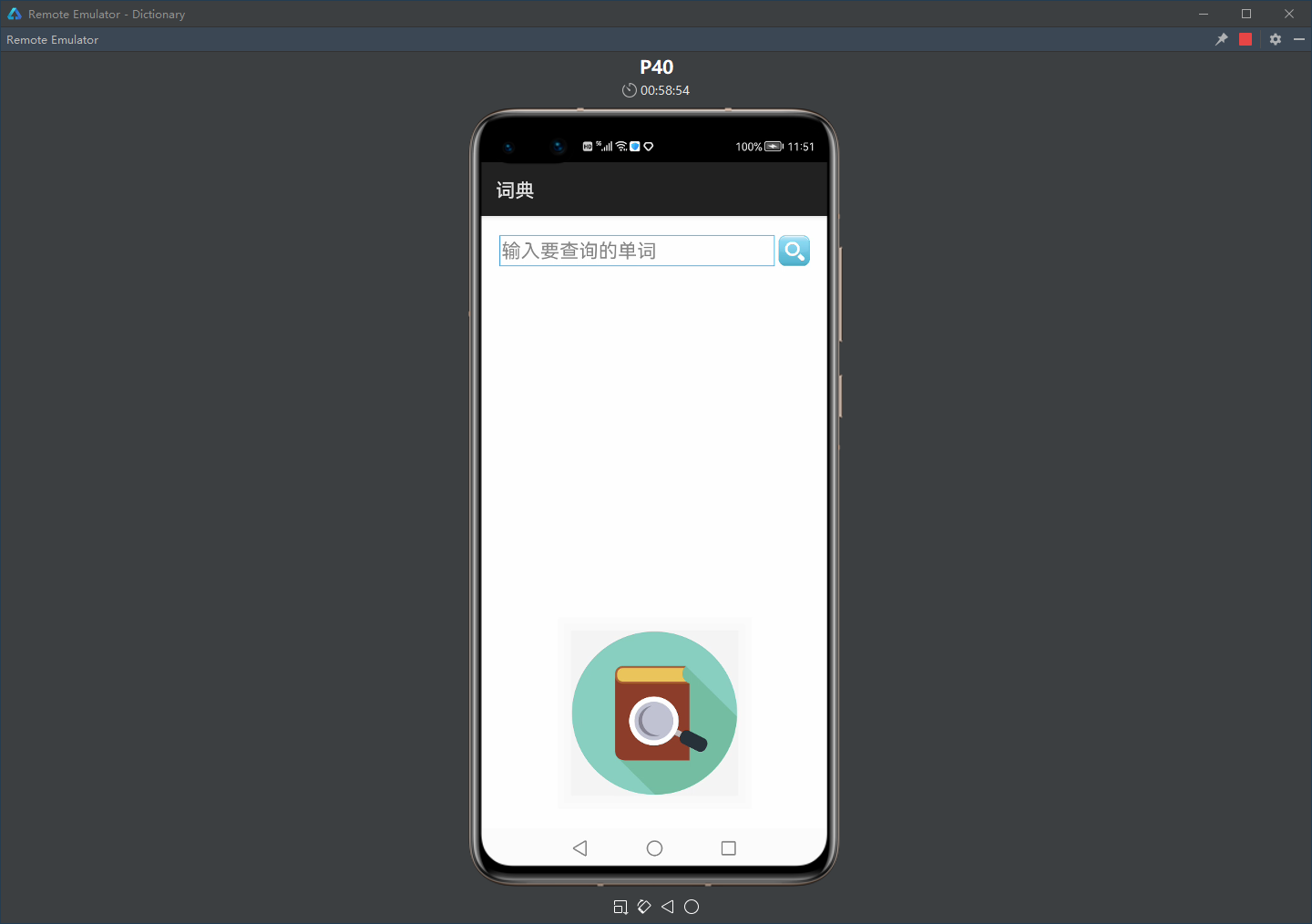
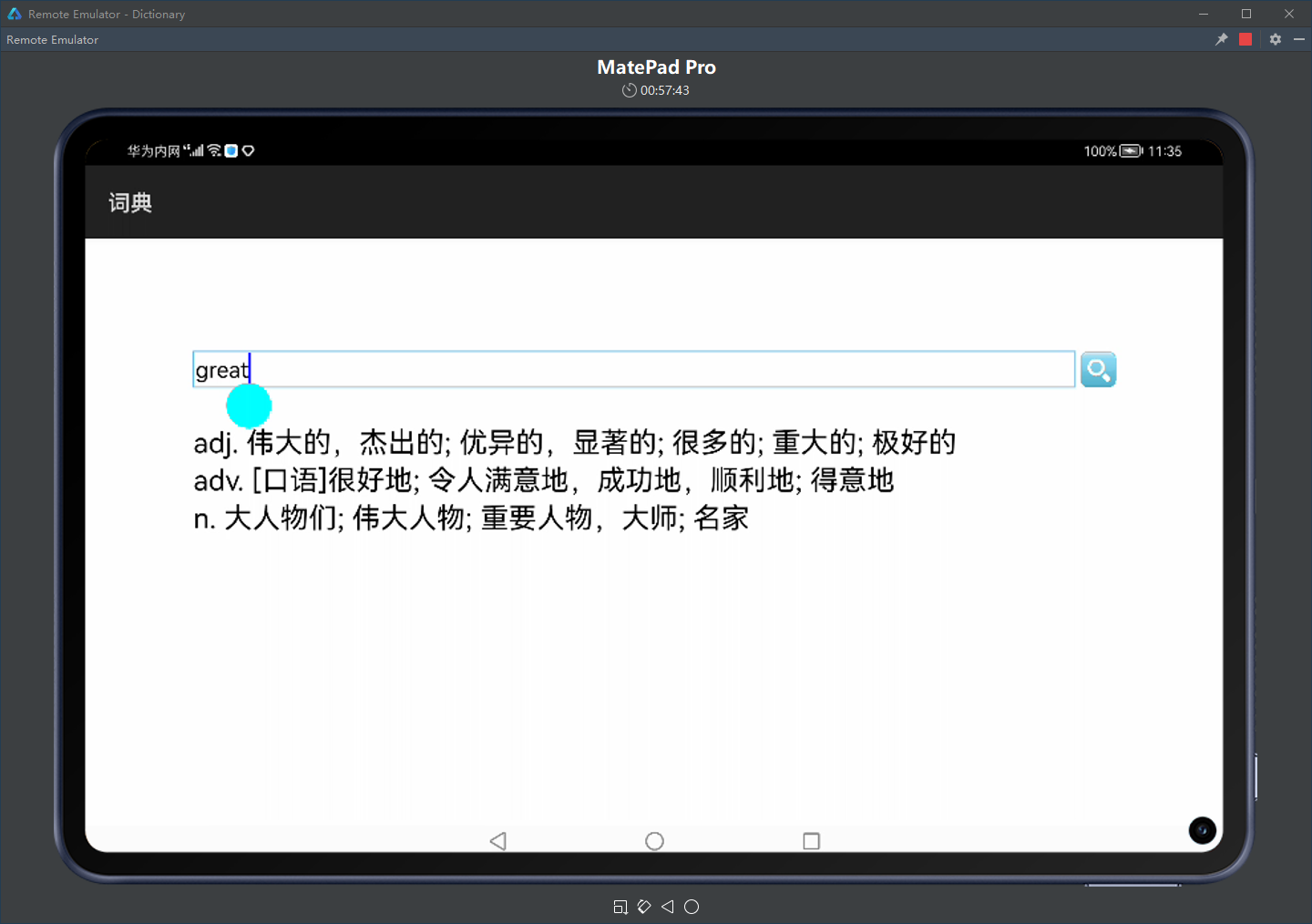
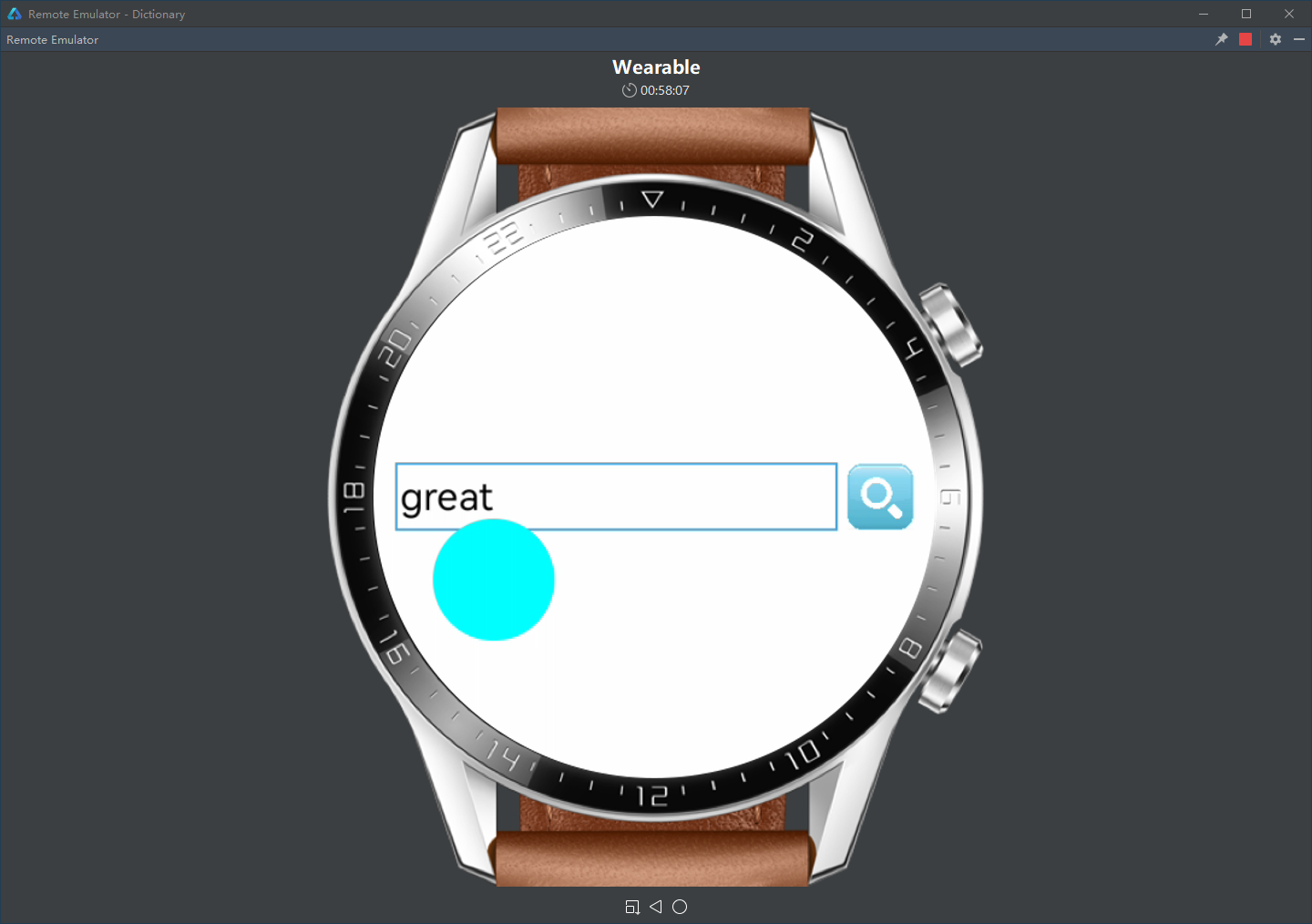
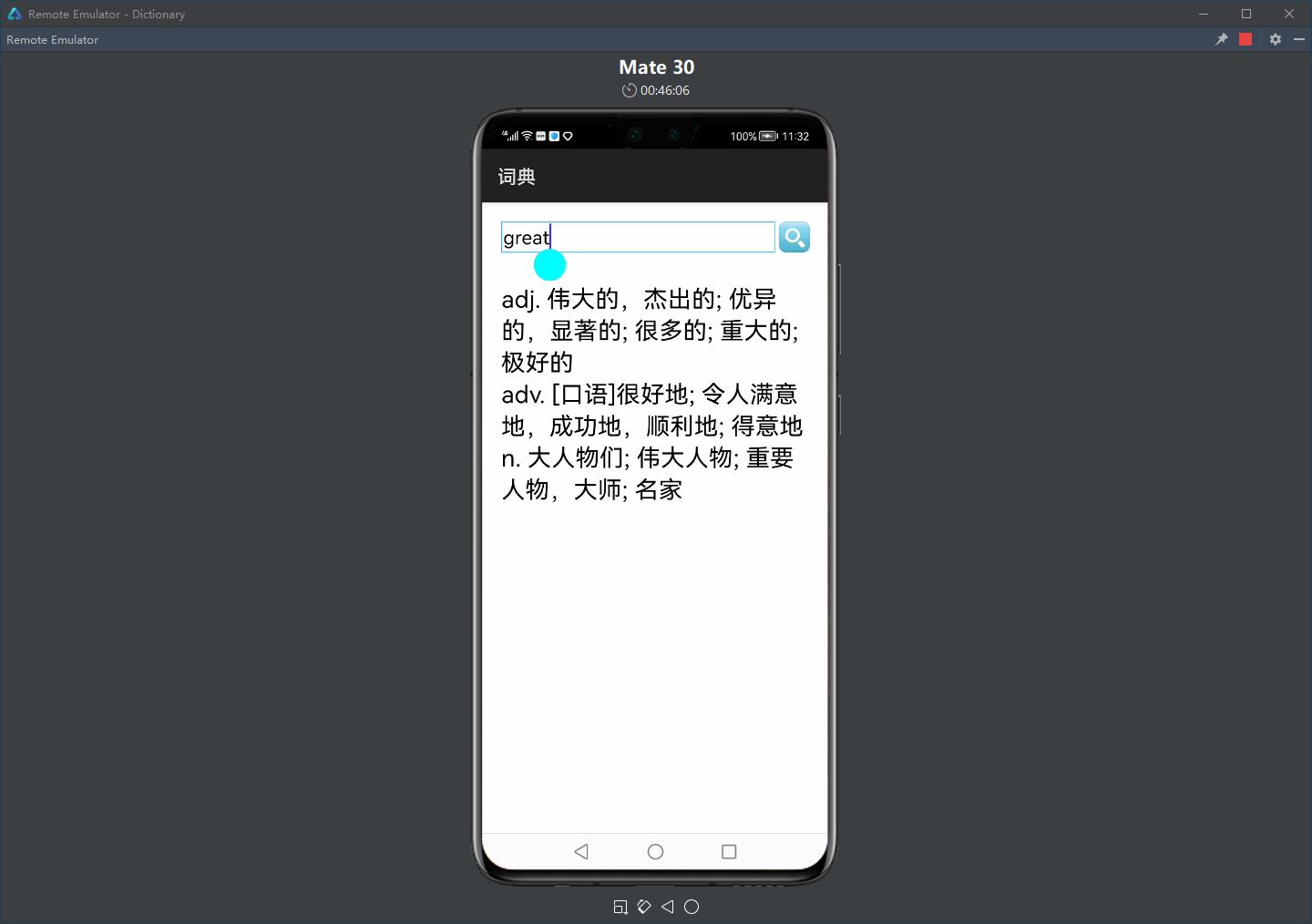

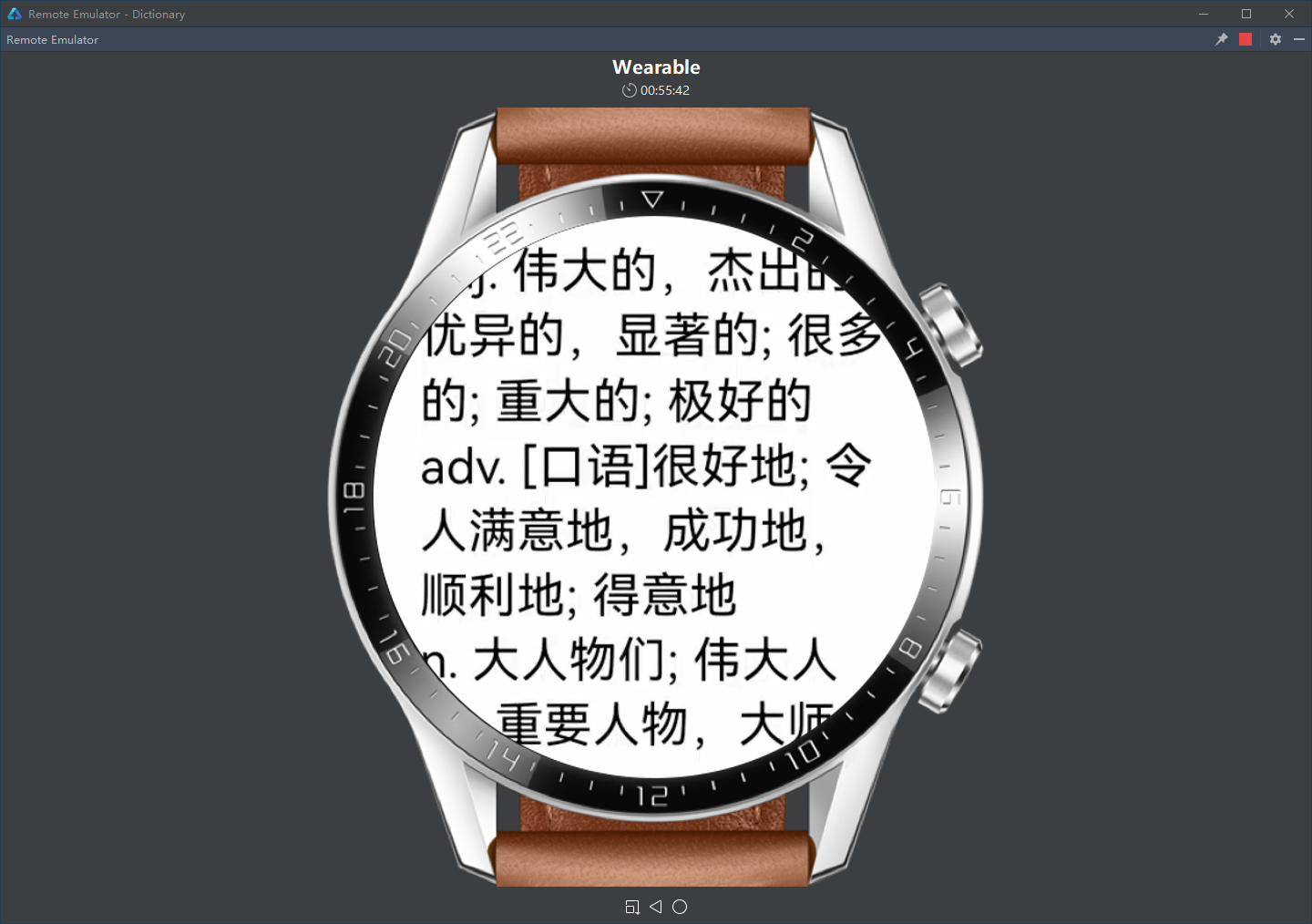
3.2 网络爬虫技术
利用爬虫技术构建本地词库。
3.3 关系型数据库技术
将本地词库保存在SQLite数据库中。
3.4 网络通信技术
通过网络访问Web服务器上的资源。
3.5 数据挖掘技术
从复杂的网页信息中挖掘出感兴趣的关键内容并将其结构化。
4 开发步骤
4.1 创建跨设备工程
通过DevEco Studio创建工程,选择Empty Ability(Java)模板,并在设备类型中同时勾选Phone、Tablet、TV和Wearable。
在entry\src\main\config.json文件中可以看到:
"deviceType": [ "phone", "tablet", "tv", "wearable" ]
在中英文字符串资源文件中修改应用的标签和描述。
entry\src\main\resources\en\element\string.json:
{ "string": [ { "name": "entry_MainAbility", "value": "Dictionary" }, { "name": "mainability_description", "value": "Online Electronic Dictionary" }, { "name": "mainability_HelloWorld", "value": "Hello World" } ] }
entry\src\main\resources\zh\element\string.json:
{ "string": [ { "name": "entry_MainAbility", "value": "词典" }, { "name": "mainability_description", "value": "在线电子词典" }, { "name": "mainability_HelloWorld", "value": "你好,世界" } ] }
4.2 设计界面布局
4.2.1 为不同设备编写布局脚本
在entry\src\main\resources\base\graphic目录下创建background_textfield.xml文件,为单词编辑框定义背景样式:
<?xml version="1.0" encoding="UTF-8" ?> <shape xmlns:ohos="http://schemas.huawei.com/res/ohos" ohos:shape="rectangle"> <solid ohos:color="#ffffff"/> <stroke ohos:width="1vp" ohos:color="#4fa5d5"/> </shape>
将搜索图片search.png放到entry\src\main\resources\base\media目录下:

将封面图片cover.png放到entry\src\main\resources\base\media目录下:

电视布局entry\src\main\resources\base\layout\ability_main_tv.xml:
<DirectionalLayout xmlns:ohos="http://schemas.huawei.com/res/ohos" ohos:height="match_parent" ohos:width="match_parent" ohos:left_padding="200vp" ohos:right_padding="200vp" ohos:top_padding="60vp" ohos:bottom_padding="60vp" ohos:orientation="vertical"> <DirectionalLayout ohos:height="match_content" ohos:width="match_parent" ohos:alignment="center" ohos:orientation="horizontal"> <TextField ohos:id="$+id:tfWord" ohos:height="match_content" ohos:width="match_parent" ohos:weight="1" ohos:padding="2vp" ohos:background_element="$graphic:background_textfield" ohos:hint="输入要查询的单词" ohos:text_size="20fp" /> <Image ohos:id="$+id:imgSearch" ohos:height="32vp" ohos:width="32vp" ohos:left_margin="4vp" ohos:image_src="$media:search" ohos:scale_mode="zoom_center" /> </DirectionalLayout> <DependentLayout ohos:height="match_parent" ohos:width="match_parent" ohos:top_margin="30vp"> <Text ohos:id="$+id:txtResult" ohos:height="match_content" ohos:width="match_parent" ohos:multiple_lines="true" ohos:text_size="25fp" /> <Image ohos:id="$+id:imgCover" ohos:height="match_content" ohos:width="match_content" ohos:center_in_parent="true" ohos:align_parent_bottom="true" ohos:image_src="$media:cover" /> </DependentLayout> </DirectionalLayout>
预览效果如下图所示:
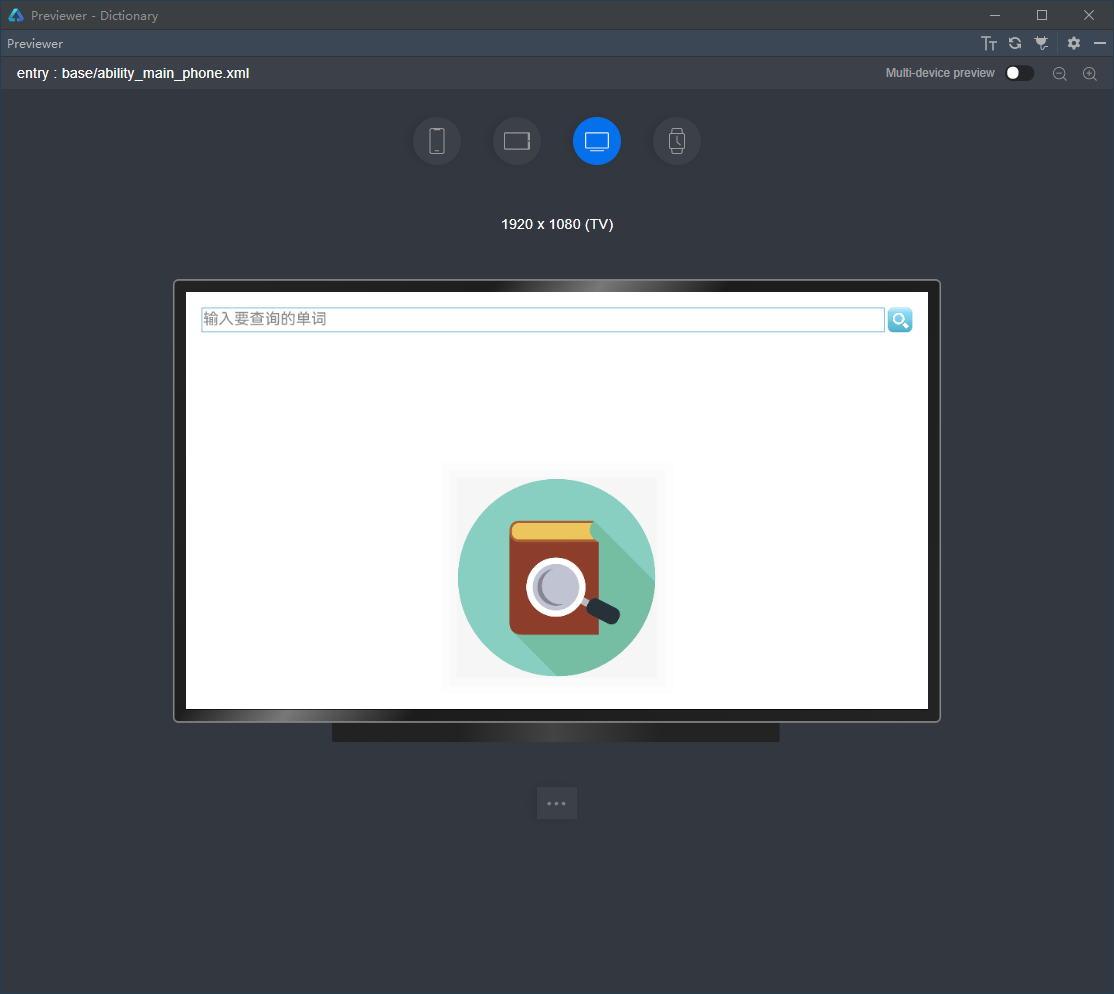
平板布局entry\src\main\resources\base\layout\ability_main_tablet.xml:
<DirectionalLayout xmlns:ohos="http://schemas.huawei.com/res/ohos" ohos:height="match_parent" ohos:width="match_parent" ohos:padding="100vp" ohos:orientation="vertical"> <DirectionalLayout ohos:height="match_content" ohos:width="match_parent" ohos:alignment="center" ohos:orientation="horizontal"> <TextField ohos:id="$+id:tfWord" ohos:height="match_content" ohos:width="match_parent" ohos:weight="1" ohos:padding="2vp" ohos:background_element="$graphic:background_textfield" ohos:hint="输入要查询的单词" ohos:text_size="20fp" /> <Image ohos:id="$+id:imgSearch" ohos:height="32vp" ohos:width="32vp" ohos:left_margin="4vp" ohos:image_src="$media:search" ohos:scale_mode="zoom_center" /> </DirectionalLayout> <DependentLayout ohos:height="match_parent" ohos:width="match_parent" ohos:top_margin="30vp"> <Text ohos:id="$+id:txtResult" ohos:height="match_content" ohos:width="match_parent" ohos:multiple_lines="true" ohos:text_size="25fp" /> <Image ohos:id="$+id:imgCover" ohos:height="match_content" ohos:width="match_content" ohos:center_in_parent="true" ohos:align_parent_bottom="true" ohos:image_src="$media:cover" /> </DependentLayout> </DirectionalLayout>
预览效果如下图所示:
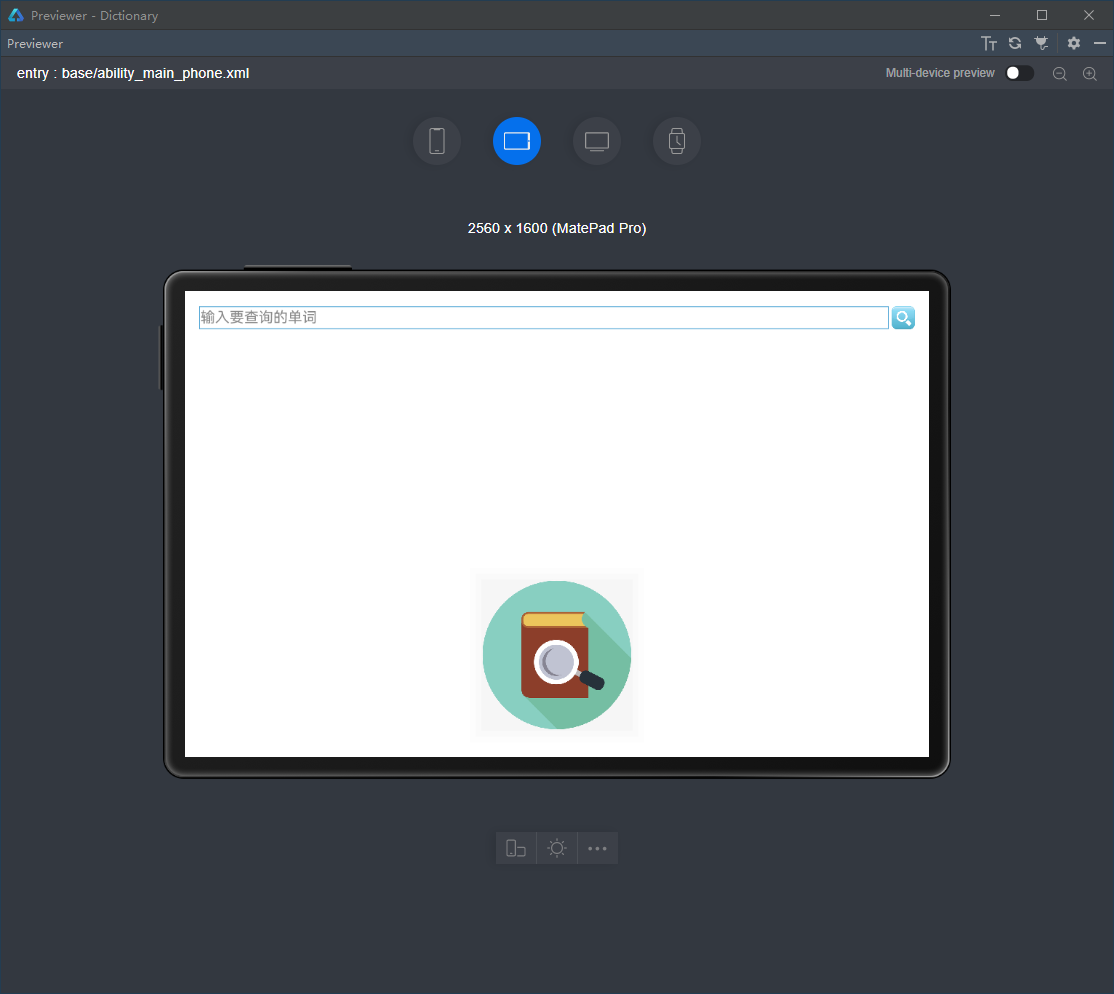
手机布局entry\src\main\resources\base\layout\ability_main_phone.xml:
<DirectionalLayout xmlns:ohos="http://schemas.huawei.com/res/ohos" ohos:height="match_parent" ohos:width="match_parent" ohos:padding="20vp" ohos:orientation="vertical"> <DirectionalLayout ohos:height="match_content" ohos:width="match_parent" ohos:alignment="center" ohos:orientation="horizontal"> <TextField ohos:id="$+id:tfWord" ohos:height="match_content" ohos:width="match_parent" ohos:weight="1" ohos:padding="2vp" ohos:background_element="$graphic:background_textfield" ohos:hint="输入要查询的单词" ohos:text_size="20fp" /> <Image ohos:id="$+id:imgSearch" ohos:height="32vp" ohos:width="32vp" ohos:left_margin="4vp" ohos:image_src="$media:search" ohos:scale_mode="zoom_center" /> </DirectionalLayout> <DependentLayout ohos:height="match_parent" ohos:width="match_parent" ohos:top_margin="30vp"> <Text ohos:id="$+id:txtResult" ohos:height="match_content" ohos:width="match_parent" ohos:multiple_lines="true" ohos:text_size="25fp" /> <Image ohos:id="$+id:imgCover" ohos:height="match_content" ohos:width="match_content" ohos:center_in_parent="true" ohos:align_parent_bottom="true" ohos:image_src="$media:cover" /> </DependentLayout> </DirectionalLayout>
预览效果如下图所示:
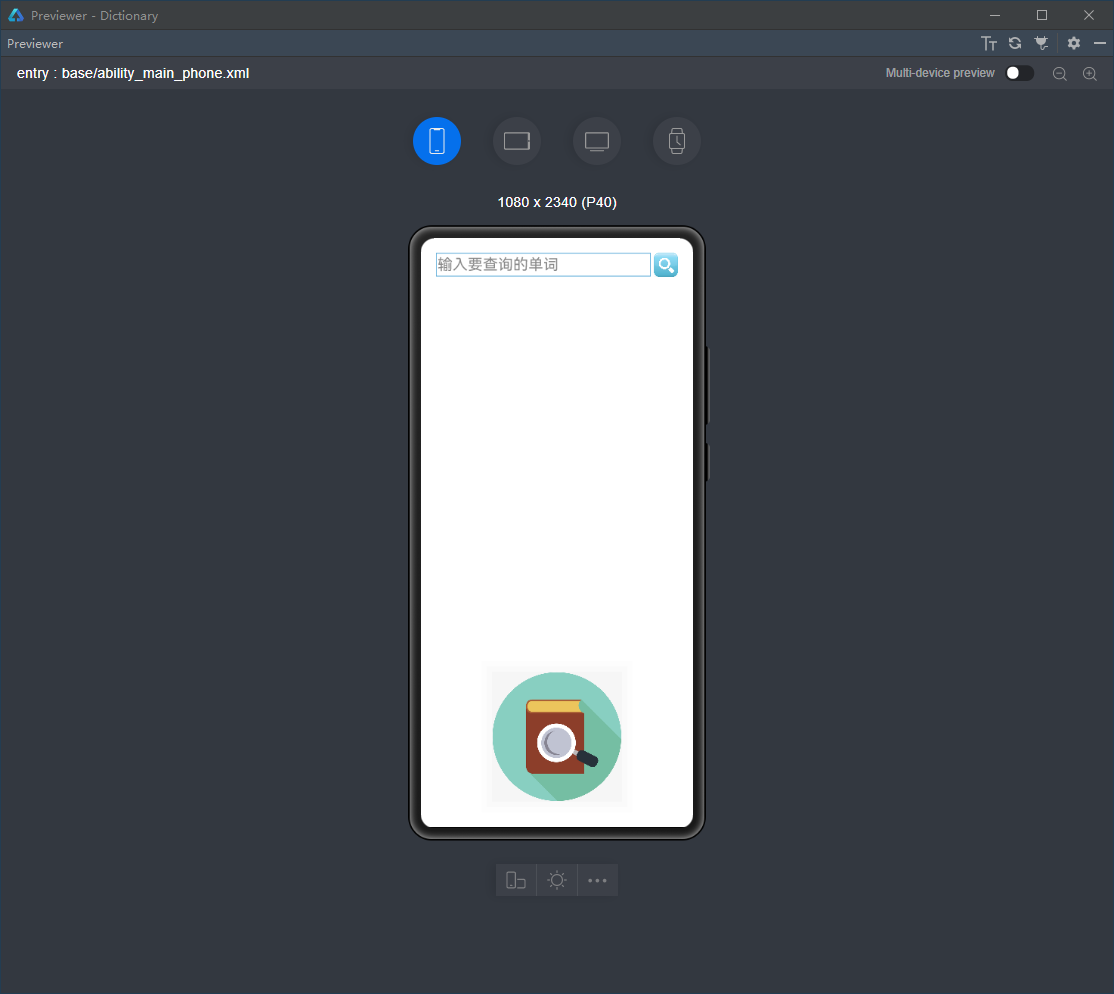
考虑到智能手表屏幕通常较小,同屏显示被查单词和查询结果会非常局促,因此采用分屏显示的方法。
手表查询页面布局entry\src\main\resources\base\layout\ability_main_wearable.xml:
<DirectionalLayout xmlns:ohos="http://schemas.huawei.com/res/ohos" ohos:height="match_parent" ohos:width="match_parent" ohos:left_padding="10vp" ohos:right_padding="10vp" ohos:alignment="center" ohos:orientation="horizontal"> <TextField ohos:id="$+id:tfWord" ohos:height="match_content" ohos:width="match_parent" ohos:weight="1" ohos:padding="2vp" ohos:background_element="$graphic:background_textfield" ohos:hint="输入要查询的单词" ohos:text_size="16fp" /> <Image ohos:id="$+id:imgSearch" ohos:height="27vp" ohos:width="27vp" ohos:left_margin="4vp" ohos:image_src="$media:search" ohos:scale_mode="zoom_center" /> </DirectionalLayout>
预览效果如下图所示:
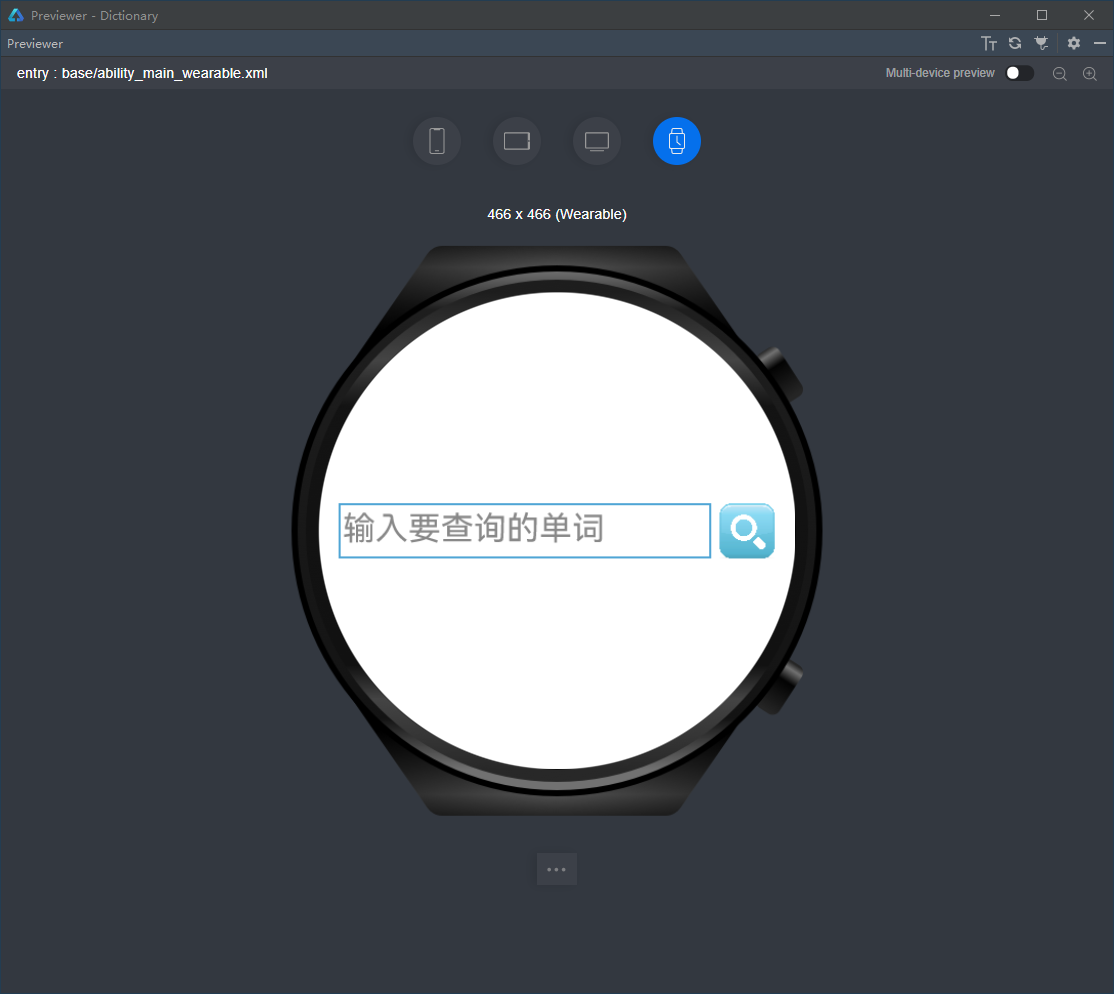
手表结果页面布局entry\src\main\resources\base\layout\ability_result_wearable.xml:
<DirectionalLayout xmlns:ohos="http://schemas.huawei.com/res/ohos" ohos:height="match_parent" ohos:width="match_parent"> <ScrollView ohos:height="match_parent" ohos:width="match_parent" ohos:rebound_effect="true"> <Text ohos:id="$+id:txtResult" ohos:height="match_content" ohos:width="match_parent" ohos:margin="20vp" ohos:layout_alignment="center" ohos:multiple_lines="true" ohos:text_size="20fp" /> </ScrollView> </DirectionalLayout>
4.2.2 根据设备类型适配界面布局
entry\src\main\java\com\minwei\dictionary\slice\MainAbilitySlice.java:
public class MainAbilitySlice extends AbilitySlice { @Override public void onStart(Intent intent) { ... switch (DeviceInfo.getDeviceType()) { case "tv": super.setUIContent( ResourceTable.Layout_ability_main_tv); break; case "tablet": super.setUIContent( ResourceTable.Layout_ability_main_tablet); break; case "wearable": super.setUIContent( ResourceTable.Layout_ability_main_wearable); break; default: super.setUIContent( ResourceTable.Layout_ability_main_phone); break; } } ... }
4.3 构建本地词库
____________
| |
| Web Server |
|____________|
|HTTP
______v_____
| |
| Web Spider |
|____________|
|SQL
______v_____ ____________
| | | |
| SQLite DB |--->| HAP |
|____________| |____________|
安装Python解释器和扩展工具包:
https://www.python.org/downloads
> python -m pip install requests > python -m pip install beautifulsoup4
CET4的页面如下图所示:
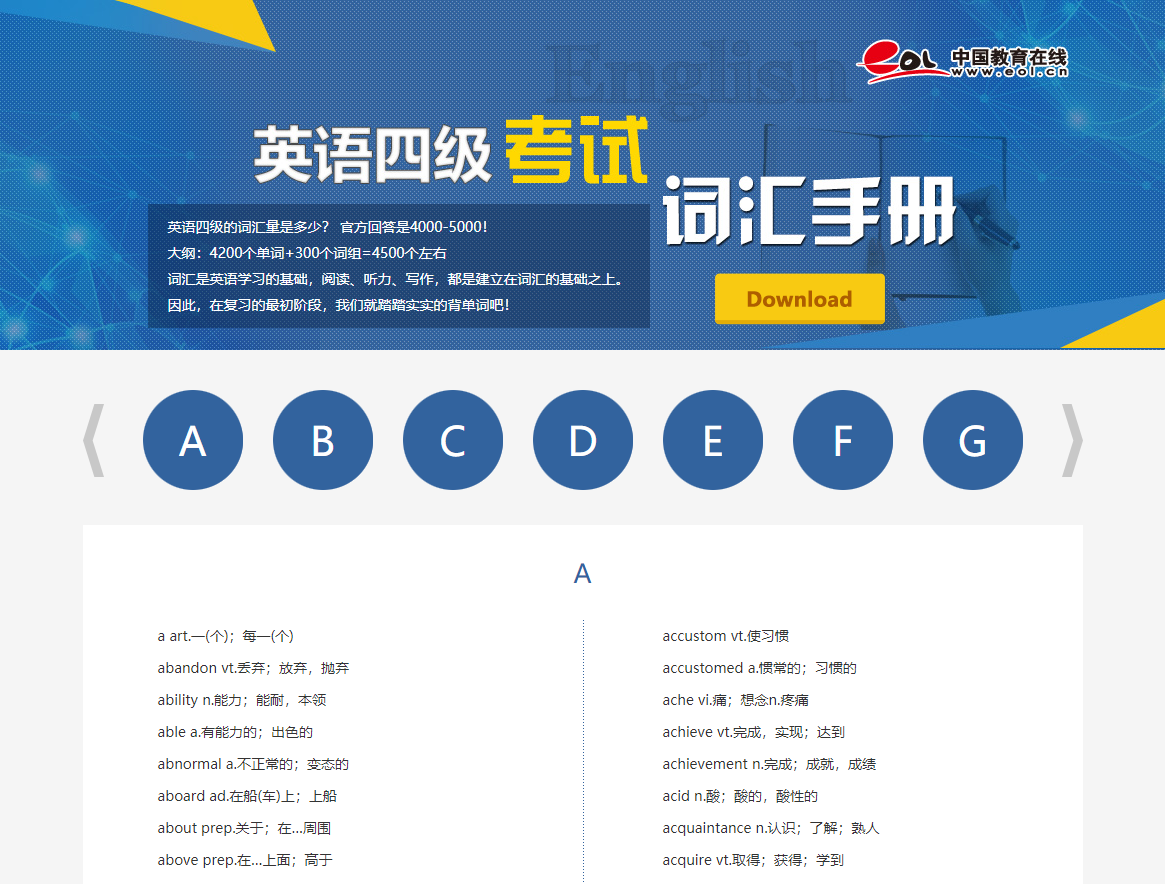
CET4的页面元素如下图所示:
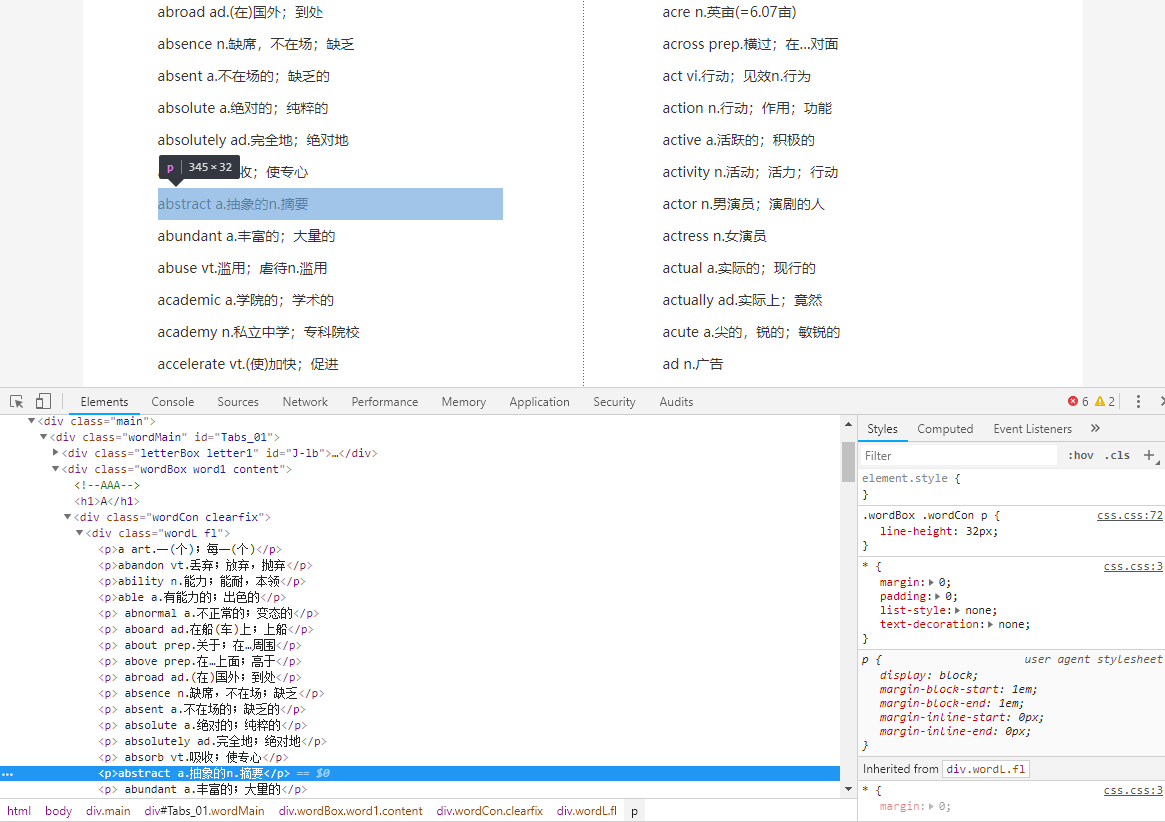
from bs4 import BeautifulSoup import requests import re import os import sqlite3 print("下载词典数据 ... ", end = ""); # 获取英语四级考试词汇手册页面内容 response = requests.get("https://www.eol.cn/html/en/cetwords/cet4.shtml") content = str(response.content, "utf-8") print("成功!"); print("抽取词典数据 ... ", end = ""); # 获取页面内容中的字头集 bs = BeautifulSoup(content, "html.parser") initials = bs.find_all(attrs = {"class": "wordL fl"}) words = {} # 单词字典(单词:词义字典) # 遍历字头集中的每一个字头 for initial in initials: # 获取字头下的词条集 entries = initial.select("p") # 遍历词条集中的每一个词条 for entry in entries: # 以词性作为正则匹配模式 pattern = re.compile("[a-z]+\.[a-z\.&\s]*") # 从词条中抽取所有的词性 part_of_speeches = pattern.findall(entry.text) # 以词性为分隔符拆分词条 fragments = re.split("[a-z]+\.[a-z\.&\s]*", entry.text) # 词条中第一个片段是单词 word = fragments[0].strip(); meanings = {} # 词义字典(词性:词义) # 遍历所有的词性 for i in range(0, len(part_of_speeches)): # 词性 part_of_speech = part_of_speeches[i].strip() # 词义 meaning = fragments[i+1].strip() # 词义字典(词性:词义) meanings[part_of_speech] = meaning # 单词字典(单词:词义字典) words[word] = meanings; print("成功!"); print("创建本地词库 ... ", end = ""); # 删除已有的数据库文件 database = "lexicon.sqlite" if os.path.exists(database): os.remove(database) # 连接数据库 connect = sqlite3.connect(database) cursor = connect.cursor() # 创建表 cursor.execute(''' create table t_words ( id integer primary key autoincrement not null, word varchar(30) not null, part_of_speech varchar(30) not null, meaning text not null)''') # 创建索引 cursor.execute(''' create index word_index on t_words(word)''') print("成功!"); print("保存词典数据 ... ", end = ""); # 将单词字典存入数据库 for word, meanings in words.items(): for part_of_speech, meaning in meanings.items(): cursor.execute(f''' insert into t_words(word, part_of_speech, meaning) values ("{word}", "{part_of_speech}", "{meaning}")''') # 提交数据库 connect.commit() # 关闭数据库 connect.close() print("成功!");
执行Python爬虫脚本,得到本地词库:
> python lexicon.py
将本地词库文件lexicon.sqlite文件拷贝到entry\src\main\resources\rawfile目录下,成为
应用资源的一部分。
4.4 抽取本地词库
将本地词库从应用资源中抽取出来,放到数据库目录下。为此,添加common包,并在common包中添加Search类:
public class Search { private final AbilityContext context; private final File lexicon; public Search(AbilityContext context) { this.context = context; File dir = new File(context.getDataDir() + "/MainAbility/databases/db"); if (!dir.exists()) dir.mkdirs(); lexicon = new File(Paths.get(dir.toString(), "lexicon.sqlite").toString()); } public void init() throws IOException { extract(); } private void extract() throws IOException { if (lexicon.exists()) lexicon.delete(); Resource res = context.getResourceManager().getRawFileEntry( "resources/rawfile/lexicon.sqlite").openRawFile(); FileOutputStream fos = new FileOutputStream(lexicon); byte[] buffer = new byte[4096]; int count; while ((count = res.read(buffer)) >= 0) fos.write(buffer, 0, count); fos.close(); res.close(); } }
在MainAbilitySlice类的onStart()方法中抽取本地词库:
public class MainAbilitySlice extends AbilitySlice { private Search search; @Override public void onStart(Intent intent) { ... search = new Search(this); try { search.init(); } catch (IOException exception) { terminateAbility(); } } ... }
4.5 响应点击“搜索”
在MainAbilitySlice类的onStart()方法中,为“搜索”图像添加点击事件处理:
public class MainAbilitySlice extends AbilitySlice { ... private TextField tfWord; private Image imgSearch; private Text txtResult; private Image imgCover; @Override public void onStart(Intent intent) { ... tfWord = (TextField)findComponentById( ResourceTable.Id_tfWord); imgSearch = (Image)findComponentById( ResourceTable.Id_imgSearch); txtResult = (Text)findComponentById( ResourceTable.Id_txtResult); imgCover = (Image)findComponentById( ResourceTable.Id_imgCover); imgSearch.setClickedListener( component -> { if (imgCover != null) imgCover.setVisibility(Component.HIDE); }); } ... }
4.6 打开本地词库
在Search类中添加:
public class Search { ... private final StoreConfig config = StoreConfig.newDefaultConfig("lexicon.sqlite"); private static final RdbOpenCallback callback = new RdbOpenCallback() { @Override public void onCreate(RdbStore rdbStore) { } @Override public void onUpgrade(RdbStore rdbStore, int i, int i1) { } }; private RdbStore store; ... public void init() throws IOException { ... store = new DatabaseHelper(context).getRdbStore( config, 1, callback, null); } ... }
store将用于后续对本地词库的访问。
4.7 查询本地词库
在common包中添加Entry类:
public class Entry { private String partOfSpeech; private String meaning; public Entry(String partOfSpeech, String meaning) { this.partOfSpeech = partOfSpeech; this.meaning = meaning; } public String getPartOfSpeech() { return partOfSpeech; } public String getMeaning () { return meaning; } }
为Search类添加local()方法:
public class Search { ... public List<Entry> local(String word) { List<Entry> result = new ArrayList<>(); ResultSet resultSet = store.querySql( "select part_of_speech, meaning from t_words where word=?", new String[] {word.toLowerCase()}); while (resultSet.goToNextRow()) result.add(new Entry(resultSet.getString(0), resultSet.getString(1))); resultSet.close(); return result; } ... }
在MainAbilitySlice类的onStart()方法中,为“搜索”图像的点击事件处理添加本地查词功能:
public class MainAbilitySlice extends AbilitySlice { ... @Override public void onStart(Intent intent) { ... imgSearch.setClickedListener(component -> { if (imgCover != null) { ... List<Entry> result = search.local( tfWord.getText()); if (!result.isEmpty()) { txtResult.setText(""); for (Entry entry : result) txtResult.append(entry.getPartOfSpeech() + " " + entry.getMeaning() + "\n"); } else txtResult.setText("很遗憾,没查到。╮(╯ɛ╰)╭"); } }); } ... }
4.8 查询线程与结果回调
在common包中添加ResultCallback接口:
public interface ResultCallback { void onResult(List<Entry> result); }
在common包中添加SearchThread类:
public class SearchThread extends Thread { private String word; private RdbStore store; private ResultCallback callback; public SearchThread(String word, RdbStore store, ResultCallback callback) { this.word = word; this.store = store; this.callback = callback; } @Override public void run() { } }
4.9 实现查询线程过程
将jsoup包复制到entry\src\main\java\org\jsoup。
爱词霸的页面如下图所示:
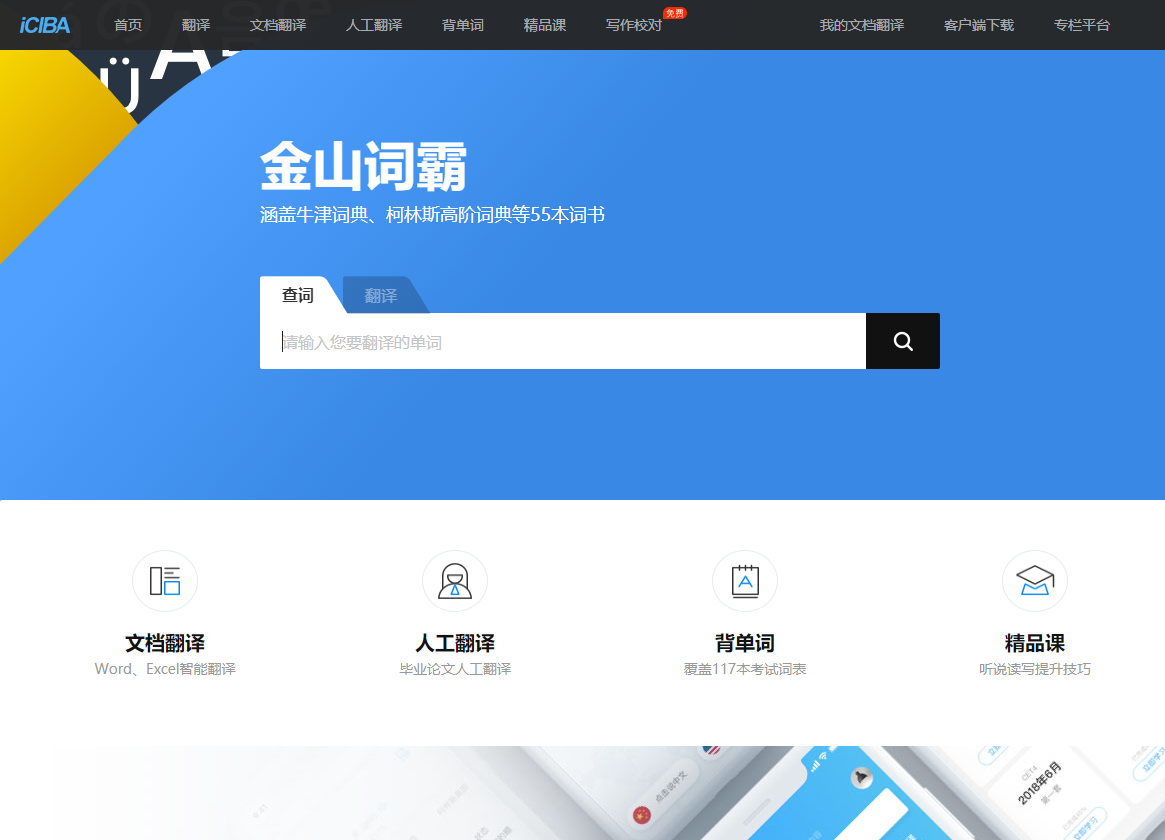
爱词霸的页面元素如下图所示:
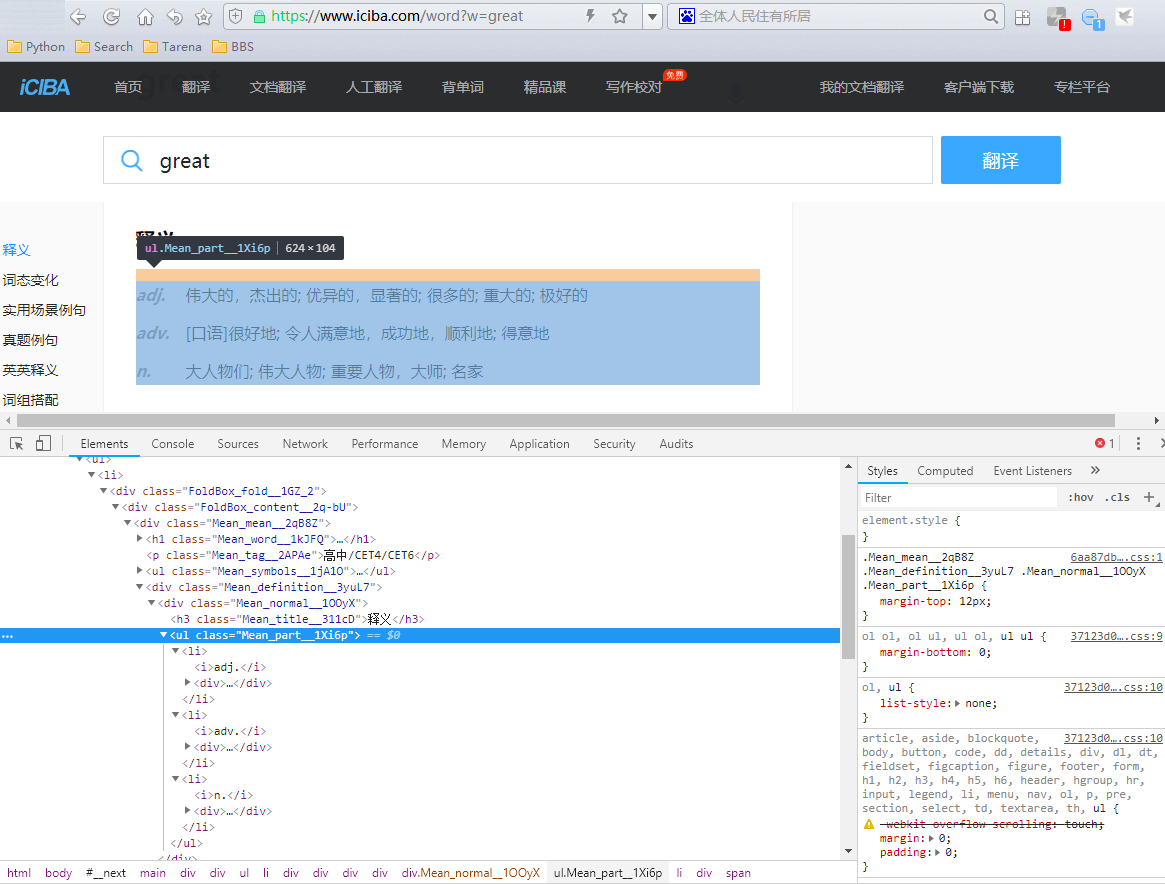
实现SearchThread类的run()方法:
public class SearchThread extends Thread { ... @Override public void run() { List<Entry> result = new ArrayList<>(); try { Document doc = Jsoup.connect("https://www.iciba.com/word?w=" + word.toLowerCase()).get(); for (Element li : doc.getElementsByClass( "Mean_part__1Xi6p").first().getElementsByTag("li")) { String partOfSpeech = new String(); String meaning = new String(); try { partOfSpeech = li.getElementsByTag("i").first().text(); } catch (Exception exception) {} try { meaning = li.getElementsByTag("div").first().text(); } catch (Exception exception) {} result.add(new Entry(partOfSpeech, meaning)); store.executeSql( "insert into t_words(word, part_of_speech, meaning) values(?,?,?)", new String[] {word, partOfSpeech, meaning}); } } catch (Exception exception) {} if(callback != null) callback.onResult(result); } }
4.10 查询远程词库
在common包中添加EventHandler类的子类ResultEventHandler:
public class ResultEventHandler extends EventHandler { public static final int RESULT_EVENT = 100; private List<Entry> result; private Text txtResult; public ResultEventHandler(EventRunner runner, List<Entry> result, Text txtResult) { super(runner); this.result = result; this.txtResult = txtResult; } @Override protected void processEvent(InnerEvent event) { super.processEvent(event); if (event.eventId == RESULT_EVENT) { if (!result.isEmpty()) { txtResult.setText(""); for (Entry entry : result) txtResult.append(entry.getPartOfSpeech() + " " + entry.getMeaning() + "\n"); } else txtResult.setText("很遗憾,没查到。╮(╯ɛ╰)╭"); } } }
为Search类添加remote()方法:
public class Search { ... public void remote(String word, ResultCallback callback) { new SearchThread(word, store, callback).start(); } ... }
在MainAbilitySlice类的onStart()方法中,为“搜索”图像的点击事件处理添加远程查词功能:
public class MainAbilitySlice extends AbilitySlice { ... @Override public void onStart(Intent intent) { ... imgSearch.setClickedListener( component -> { if (imgCover != null) { ... if (!result.isEmpty()) { ... } else { txtResult.setText("查询远程词库。。。"); search.remote(tfWord.getText(), new ResultCallback() { @Override public void onResult(List<Entry> result) { new ResultEventHandler( EventRunner.getMainEventRunner(), result, txtResult).sendEvent( ResultEventHandler.RESULT_EVENT); } }); } } }); } ... }
为了获得访问网络的权限,在config.json中添加:
"reqPermissions": [ { "name": "ohos.permission.INTERNET", "reason": "internet", "usedScene": { "ability": ["com.hotest.dictionary.MainAbility"], "when": "always" } } ]
4.11 适配智能手表
添加ResultWearableAbility。
将ResultWearableAbilitySlice中的布局改为Layout_ability_result_wearable:
public class ResultWearableAbilitySlice extends AbilitySlice { @Override public void onStart(Intent intent) { ... super.setUIContent(ResourceTable.Layout_ability_result_wearable); } ... }
删除Layout_ability_result_wearable2和ResultWearableAbility。
删除config.json中的:
{ "orientation": "unspecified", "name": "com.hostest.dictionary.ResultWearableAbility", "icon": "$media:icon", "description": "$string:resultwearableability_description", "label": "$string:entry_ResultWearableAbility", "type": "page", "launchType": "standard" }
在MainAbilitySlice类onStart()方法中,为if (imgCover != null)增加else分支,跳转到ResultWearableAbilitySlice,同时传递参数:
public class MainAbilitySlice extends AbilitySlice { ... @Override public void onStart(Intent intent) { ... imgSearch.setClickedListener( component -> { if (imgCover != null) { ... } else { IntentParams params = new IntentParams(); params.setParam("search", search); params.setParam("word", tfWord.getText()); present(new ResultWearableAbilitySlice(), new Intent().setParams(params)); } }); } ... }
在ResultWearableAbilitySlice类的onStart()方法中触发查询:
public class ResultWearableAbilitySlice extends AbilitySlice { private Text txtResult; @Override public void onStart(Intent intent) { ... IntentParams params = intent.getParams(); Search search = (Search)params.getParam("search"); String word = (String)params.getParam("word"); txtResult = (Text)findComponentById( ResourceTable.Id_txtResult); List<Entry> result = search.local(word); if (!result.isEmpty()) { txtResult.setText(""); for (Entry entry : result) txtResult.append(entry.getPartOfSpeech() + " " + entry.getMeaning() + "\n"); } else { txtResult.setText("查询远程词库。。。"); search.remote(word, new ResultCallback() { @Override public void onResult(List<Entry> result) { new ResultEventHandler( EventRunner.getMainEventRunner(), result, txtResult).sendEvent( ResultEventHandler.RESULT_EVENT); } }); } } ... }
运行效果如下图所示:



4.12 真机部署
在AppGallery上发布,通过自动签名部署到真机。
5 项目总结
在本实训项目中综合使用了鸿蒙操作系统提供的Java UI框架、SQLite数据库、基于jsoup的远程数据访问、多线程和线程间通信以及多设备适配等关键技术。编程语言是软件开发人员的生存之本。熟练掌握多种开发语言,并在最适当的场合使用最适当的语言,是对软件开发工程师尤其是应用软件开发工程师的起码要求。在本实训项目中,使用Python语言快速地构建本地词库,这比只使用一种编程语言和开发环境完成项目开发要高效得多。一般而言,对运行效率要求不高的场合,以Python、Shell等为代表的脚本化语言最为适合,在对性能要求较高的业务处理中,Java语言堪当此任,而在对性能要求最高的系统底层,则是C和C++的天下。那么如何使用C/C++语言开发各种组件,并在Java UI或JS UI框架下使用呢?我们将在后续课程中和大家分享。